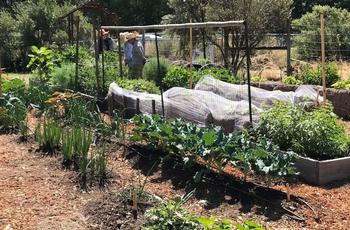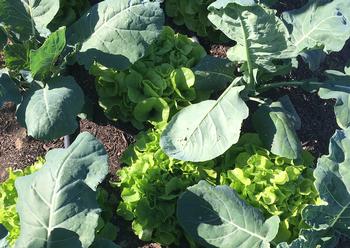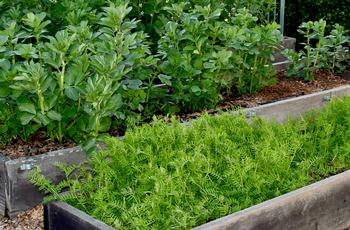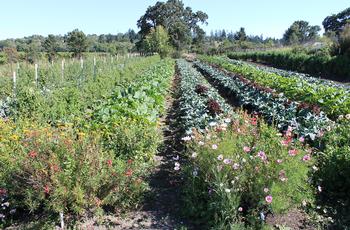
The Marin Master Gardener No Dig Edible Demonstration Garden at the Indian Valley Organic Farm and Garden. Photo: Marin Master Gardeners
Gardeners are increasingly practicing an earth-friendly set of gardening principles collectively known as No Dig. They have found that in the garden, less really can be more. In addition to the obvious time and energy saved by not digging or turning the soil, gardeners can enjoy bountiful harvests while taking an extra measure of satisfaction, knowing that they are building healthy soil. No Dig gardening allows the gardener to act locally while thinking globally. More than just retiring the rototiller, No Dig gardening is a science-based reset of how the gardener and the garden can work together with nature. Much like the No-Till agricultural movement that revolutionized grain growing after the Dust Bowl, the No Dig doctrine emphasizes minimal soil disturbance and maximum soil protection.

Intercropping in a commercial No Dig garden is an efficient and artful way to extend the harvest. Photo: Elizabeth Kaiser of Singing Frog Farms
Gardening, while a labor of love, is still very much a labor. Digging garden soil can wear out even the most passionate gardener. Healthy soil is alive. Every shovel into the garden destroys billions of microorganisms, including bacteria, fungi, and earthworms that inhabit the soil. These creatures break down the plant litter that, in nature, forms a protective blanket. The decayed organic materials then bind with natural mineral elements to form a vital zone that interacts directly with plant roots, nurturing the growing plant. Scientists call this placenta-like zone the rhizosphere. The rhizosphere is a vast, largely untapped planetary “sink” for atmospheric carbon sequestration. In No Dig gardens, the rhizosphere is revitalized by generous applications of carbon-rich compost that is also sequestered. Research has demonstrated that plant growth increases when compost is added to the soil, allowing even more carbon to be siphoned from the atmosphere. It’s a cycle. Since No Dig gardens prescribes generous quantities of locally sourced compost, the gardener is helping, garden by garden, to mitigate climate change.

Cover crops of vetch and fava beans in No Dig raised beds are ready to mow. Photo: Lori Dang
Creating a new No Dig garden is the intersection of art, design, and science. They can be created anywhere. On smaller sites, raised beds or aluminum tubs can be set up to follow No Dig principles. It is best to begin in the fall, especially if you are growing cover crops. In the raised beds pictured with this article, the lush green cover crops of vetch and fava beans were seeded in the fall. By February, this crop was ready to be cut and laid on top of the soil to serve as green manure. The roots will always remain in the soil because they are very important nitrogen sources. Over this green manure, the gardener will simply add a fresh layer of compost. After a few weeks, this raised bed garden will be ready to replant and mulch with a final 4 to 6-inch layer of rice straw. A slightly different method is recommended to create a No Dig Garden from a lawn. This method is like sheet composting, where the lawn is mowed, leaving the clippings on the soil.

No Dig practices can be successful on larger commercial gardens. Photo: Elizabeth Kaiser of Singing Frog Farms in Sonoma
Then, overlapping layers of cardboard or newspaper are placed over the new site to block weed germination. A 4-to-6-inch layer of compost is then added, followed perhaps by another layer of cardboard. There is no precise recipe for this lasagna-like garden. It can be several layers. It’s an art. Each layer should be sprinkled with water. The garden is easily planted by creating slits in the cardboard or planting directly into the compost. After planting, the final topping is a 4-to-6-inch layer of organic mulch. This mulch layer will protect the garden and aid in water retention. At the end of the growing season, this layer of mulch will be added to the compost bin, completing its own cycle and contributing to the next.
 The Marin Master Gardener No Dig Edible Demonstration Garden at the Indian Valley Organic Farm and Garden. Photo: Marin Master Gardeners
The Marin Master Gardener No Dig Edible Demonstration Garden at the Indian Valley Organic Farm and Garden. Photo: Marin Master Gardeners Intercropping in a commercial No Dig garden is an efficient and artful way to extend the harvest. Photo: Elizabeth Kaiser of Singing Frog FarmsCreating a new No Dig garden is the intersection of art, design, and science. They can be created anywhere. On smaller sites, raised beds or aluminum tubs can be set up to follow No Dig principles. It is best to begin in the fall, especially if you are growing cover crops. In the raised beds pictured with this article, the lush green cover crops of vetch and fava beans were seeded in the fall. By February, this crop was ready to be cut and laid on top of the soil to serve as green manure. The roots will always remain in the soil because they are very important nitrogen sources. Over this green manure, the gardener will simply add a fresh layer of compost. After a few weeks, this raised bed garden will be ready to replant and mulch with a final 4 to 6-inch layer of rice straw. A slightly different method is recommended to create a No Dig Garden from a lawn. This method is like sheet composting, where the lawn is mowed, leaving the clippings on the soil.
Intercropping in a commercial No Dig garden is an efficient and artful way to extend the harvest. Photo: Elizabeth Kaiser of Singing Frog FarmsCreating a new No Dig garden is the intersection of art, design, and science. They can be created anywhere. On smaller sites, raised beds or aluminum tubs can be set up to follow No Dig principles. It is best to begin in the fall, especially if you are growing cover crops. In the raised beds pictured with this article, the lush green cover crops of vetch and fava beans were seeded in the fall. By February, this crop was ready to be cut and laid on top of the soil to serve as green manure. The roots will always remain in the soil because they are very important nitrogen sources. Over this green manure, the gardener will simply add a fresh layer of compost. After a few weeks, this raised bed garden will be ready to replant and mulch with a final 4 to 6-inch layer of rice straw. A slightly different method is recommended to create a No Dig Garden from a lawn. This method is like sheet composting, where the lawn is mowed, leaving the clippings on the soil. Cover crops of vetch and fava beans in No Dig raised beds are ready to mow. Photo: Lori DangThen, overlapping layers of cardboard or newspaper are placed over the new site to block weed germination. A 4-to-6-inch layer of compost is then added, followed perhaps by another layer of cardboard. There is no precise recipe for this lasagna-like garden. It can be several layers. It’s an art. Each layer should be sprinkled with water. The garden is easily planted by creating slits in the cardboard or planting directly into the compost. After planting, the final topping is a 4-to-6-inch layer of organic mulch. This mulch layer will protect the garden and aid in water retention. At the end of the growing season, this layer of mulch will be added to the compost bin, completing its own cycle and contributing to the next.
Cover crops of vetch and fava beans in No Dig raised beds are ready to mow. Photo: Lori DangThen, overlapping layers of cardboard or newspaper are placed over the new site to block weed germination. A 4-to-6-inch layer of compost is then added, followed perhaps by another layer of cardboard. There is no precise recipe for this lasagna-like garden. It can be several layers. It’s an art. Each layer should be sprinkled with water. The garden is easily planted by creating slits in the cardboard or planting directly into the compost. After planting, the final topping is a 4-to-6-inch layer of organic mulch. This mulch layer will protect the garden and aid in water retention. At the end of the growing season, this layer of mulch will be added to the compost bin, completing its own cycle and contributing to the next. No Dig practices can be successful on larger commercial gardens. Photo: Elizabeth Kaiser of Singing Frog Farms in Sonoma
No Dig practices can be successful on larger commercial gardens. Photo: Elizabeth Kaiser of Singing Frog Farms in Sonoma



